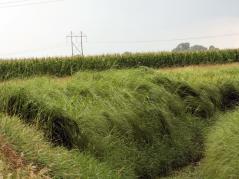University of Illinois agronomist D.K. Lee has developed a bioenergy grass that is tolerant to freezing. Current bioenergy crops such as Miscanthus and switchgrass grown in the Midwest are prone to freezing. When Lee discovered one morning in Mid-April that the only grass not frozen was prairie cordgrass he and his team began to research what molecular changes keep cordgrass, Spartina pectinata, from freezing in cold weather.
This discovery could be important for bioenergy crops due to their often being grown on marginal land where conditions are not ideal. Cordgrass, with its tolerance to several major stress factors including flooding and salt, has the potential, says Lee, to be grown in more places than other perennial crops.
“Unlike salt and flooding stress, freezing usually happens abruptly,” Lee explains. “The plant has to react quickly. To find out what was happening at the molecular level, we grew cordgrass in a growth chamber at 25 degrees Celsius and then abruptly moved them into another growth chamber set to -5 degrees. We looked at gene expression within five minutes after exposure to freezing temperatures. We found some unique genes being activated right away and then different ones turning on 30 minutes later,” added Lee.
The initial genetic response is what the researchers believe protects the cell from freezing. When a plant is exposed to freezing temperatures, crystals typically form in the spaces outside the cell. Once these “seed crystals” form, they quickly grow and burst the living cells. However, to avoid this action, the researchers believe the cordgrass may quickly pump ions outside the cell in an effort to keep ice crystals from forming or growing.
From here, the scientists surmise that in around 30 minutes secondary reactions occur that may have to do with repairing damaged cells. This would in turn allow the plant to recover more quickly.
These findings are just the beginning, says Lee, and much more needs to be done to fully understand the genetic mechanisms that enable cordgrass to avoid tissue damage during cold spells. Once the cordgrass’s system is fully understood, Lee hopes the knowledge can then be applied to other crops.
“Corn farmers are always looking to plant earlier in the spring,” said Lee. “They think if they plant early, they could see a yield benefit. Currently, crop insurance won’t cover corn if farmers plant before a certain date, because there’s a big risk of frost. If we understand more about freezing tolerance, we could eventually apply it to annual crops and potentially expand the production area for crops such as corn,” Lee concluded.


